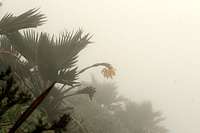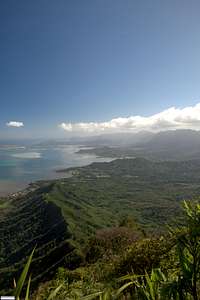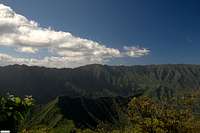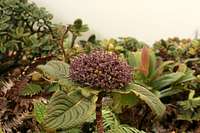|
|
Area/Range |
|---|---|
|
|
21.35320°N / 157.78870°E |
|
|
Hiking, Scrambling |
|
|
Spring, Summer, Fall, Winter |
|
|
3149 ft / 960 m |
|
|
Overview
The Ko'olau Mountains are located on the island of Oahu, in Hawaii. These mountains dominate the eastern half of the island, and are visible to the thousands that live on Oahu on a daily basis. One of the two major mountain ranges that makes up Oahu (the other being the Waianae Mountains), the Ko'olaus are shorter in elevation, but longer in distance end to end, and at least equally dramatic. Although they top out at only 3150 feet, the summit ridge consistently is over 2000 feet, and rises directly from sea level, providing a dramatically steep and beautiful mountain presence.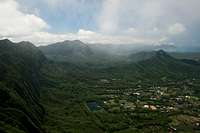 The Windward side of the Ko'olau is defined by its sheer dramatic cliffs, covered in vegetation. The peak visible on the right is Olomana.
The Windward side of the Ko'olau is defined by its sheer dramatic cliffs, covered in vegetation. The peak visible on the right is Olomana.The Ko'olaus run in a North North Westerly direction, stretching from the Oahu's Southeast point, Makapu'u, to its Northeast point, Kahuku, a distance of around 35 miles. Although extremely close to the urban centers of Hawaii, most of the Ko'olaus are nearly devoid of people. Aside from a few popular, well-maintained trails, most trails are barely maintained, overgrown, and difficult, keeping most of these mountains a great place to find solitude. Although most of the views show plenty of human development, the mountains themselves are a wilderness, containing dense forest, steep cliffs, rare plants and epic mountain and ocean views. This summit region is almost always in the clouds and was known to the ancient Hawaiians as Wao Akua, the realm of the gods, and only special Kahuna (priests) could enter and escort the commoners through to get to the valuable resources of the mountains.
The Ko'olau is not your typical mountain range, rather it is the eroded remains of a massive shield volcano that began erupting an estimated 2.5 million years ago. Several eruptions in the last half million years created separate features along the Ko'olau, such as individual cinder cones. Some of these have become Oahu's most well known landmarks, such as Diamond Head and Hanauma Bay, but also other craters like Koko Crater, Punchbowl and more. The original Ko'olau mountain may have been around 10,000 feet, but now tops off at Konahuanui, at 3,150 feet. It is this erosion however that has given the Ko'olau Mountains their dramatic and rugged appearance.
Getting There
Access to Oahu is nearly exclusively through Honolulu Airport. Most visitors to Oahu stay in Waikiki, and with a car, the Ko'olau Mountains are within easy driving distance. There are a few trails that are accessible from Waikiki by city bus.The Ko'olau's can be accessed from many locations on Oahu. In the southern Ko'olau, nearly all the trails into the mountains and to the ridge line and summits start on leeward, westerly side of the mountains. There are many trails, some starting in the back of the valleys and some start on top of the communities that live up on ridges coming down from the summit. In teh northern Ko'olau there are many trails from both the Windward and Leeward sides. There are a few well maintained popular trails, but in terms of numbers most of the trails are highly overgrown, narrow, eroded, steep and difficult. Hiking these trails is a totally different experience than hiking anywhere else, and ever experienced hikers can struggle in this wet, muddy, and vegetation covered landscape. In the Ko'olau, long pants are nearly always a must. Many local hikers and people that hike in these mountains as part of their job, wear special "tabis", spiked shoes that are designed to handle steep, muddy slopes.
The ultimate Ko'olau Mountain experience is hiking along the summit ridge. The main Ko'olau ridge line is nearly continuous, with 3 major gaps that are nearly impossible to hike and should only be attempted by those extremely experienced in hiking in these mountains. This is a totally different breed of hiking than you find nearly anywhere else. In the Northern Ko'olau hiking the ridgeline is a extremely pleasant experience, as the Ko'olau Summit Trail (KST) is a nice contour trail that runs near the summit ridge, sometimes on the windward, sometimes on the leeward side of the ridge. Expect mud and lots of it, but the views and the forest areas are absolutely spectacular. In the southern Ko'olau there is no nice contour trail, rather hikers simply bushwhack along the top of the ridge crest. Mileage is essential meaningless, and long pants are mandatory. Hiking the ridge crest is a serious undertaking, but if you are comfortable with the exposure this is a totally unique experience. It is hard to believe when staying in the crowded sprawl of Oahu, but the Ko'olau summit region is in many areas quite remote.
Few people camp and backpack in the Ko'olau Mountains. There are awesome opportunities to spend nights out in the cloud forest around the summit regions, but water is surprisingly scarce, as most streams are intermittent and unpredictable. Water usually is carried in, but if you have the motivation, camping in the high, unique cloud forest of the Ko'olau is an amazing experience. The best backpacking opportunities are found along the KST in the northern Ko'olau (more route pages and info on some of these trails/locations is coming soon).
Primary Peaks
Most people merely wish to reach the general summit ridge line, the top of the Ko'olau Pali (Cliffs). There are however several highly distinct peaks in the Ko'olau that make for great destinations. Some are high points along the ridge, while others are separate from the main ridge. Here I include some of the most prominent and popular peaks. Many include the prefix Pu'u, simply translated in Hawaiian as Mount. These are not necessarily the highest peaks, but the most important, well-known, and prominent.Konahuanui 3150 ft (960 m)
Puu Keahi a Kahoe 2820 ft (860 m)
Puu Lanihuli 2770 ft (844 m)
Puu Kahuauli 2740 ft (835 m)
Puu Kaaumakula 2681 ft (817 m)
Mount Olympus 2486 ft (758 m)
Puu Kainapuaa 2360 ft (719 m)
Puu Ohulehule 2265 ft (690 m)
Puu o Kona 2200 ft (671 m)
Mount Tantalus (Puu Ohia) 2013 ft (614 m)
Puu Kanehoalani 1900 ft (579 m)
Mount Olomana 1643 ft (501 m)
Pu'u Manamana 1600 ft (488 m)
Koko Head 1208 ft (368 m)
Diamond Head 761 ft (232 m)
Red Tape
Access in the Ko'olau Mountains varies greatly. Many popular trails are owned by and maintained by the state. Some you have to enter gated communities to access, but the state has access agreements in place, and you can simply tell the security guards you are going hiking and fill out a form. Many other trails are unmaintained and cross private land, but in general private landowners allow access. The northern Ko'olau Mountains can have more issues, as much of the land is owned by the military. Still it is possible to gain access nearly anywhere, but take care to research the area you wish to get to and obtain the proper permission.Flora and Fauna
The Ko'olau Mountains contain many unique ecosystems and interesting plants and animals. There are hundreds of federally listed endangered plants and many others that are not listed but are highly rare within the Ko'olau. Lower forests of the Ko'olau are primarily made up of invasive plants, but some native Lama forest remains. The high summit regions contain most of the rare plants and are cloud forest dominated by beautiful native plants. The two most prominent trees in the mesic (moderately moist) to wet forest are the koa trees, famous for their beautiful wood that was once used to carve huge dugout canoes and is still used to make beautiful bowls and other items, and the ohia trees, taking many forms and often growing in many directions. Ohia are known for their red blossoms which the Hawaiians say represent the goddess Pele. Picking these blossoms, legend says, causes it to rain.Also found in these forests are a few endangered birds. Many of these birds are the ones featured in your standard biology textbook as an example of adaptive radiation and co-evolution (such as co-evolutions with Lobelia family of plants). The most common of these are the red apapane and the brown endangered elepaio. Also still found on Oahu are amakihi and the iconic curved beaked i'iwi, although there may be less than 10 on the island.
Also found in the Ko'olau are the critically endangered genus of Achatinella, Oahu tree snails. There were once over 40 species of the beautiful colorful and shiny snails on Oahu, with most species isolated to a single gulch of the Ko'olau. Around half of these species probably remain, with many species down to less than 50 individuals. Looking for these snails is incredibly time consuming and frustrating at times, but being able to see these tiny living jewels- shiny swirls of black, brown, green, orange, white or more makes it worth a look if you have any idea what your doing.
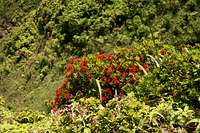 Ohia trees are the most common native tree of the high Koolau cloud forest. Here a small one is loaded with red blossoms on a rare clear and cloudless day.
Ohia trees are the most common native tree of the high Koolau cloud forest. Here a small one is loaded with red blossoms on a rare clear and cloudless day.There are many threats to the forests of the Ko'olau. Many harmful invasive species have been introduced to the island, and since the native plants had few natural predators or threats, they are often easily out-competed and overgrown. Trees such as Strawberry Guava, Cinnamon, Night Blooming Jasmine, Ironwood and many more have totally out-competed the native forest, and ground weeds such as Clidemia and Himalayan Blackberry cover the ground. There is a clear distinction between the native forest and the invasive, and sadly it now nearly always takes a hike to get to any native forest.
Animals also threaten the Ko'olau forest. Wild pigs are the biggest harm, uprooting many young native ferns and plants. Goats do the same, and rats love to feast on seeds of many plants. Two purposeful introductions have also turned out to be extremely harmful. Rosey Wolf Snails (Cannibal Snails) were introduced to eat the non-native African Snails that were eating peoples gardens, but instead they moved the the mountains and started to wipe out Native Achatinella tree snails. Mongoose were introduced to Hawaii to control rats, but since the rats are nocturnal and the mongoose are diurnal, the Mongoose have simply decimated native bird populations feasting on their eggs.
The forest of the Ko'olau is lush and beautiful, yet fragile. Enter the Ko'olau with the utmost care for this amazing array of life.
When to Hike
Hiking in the Ko'olau Mountains can be easily done year round. This is the tropics, and weather varies relatively little. There is marginally more rain in the winter months, but it can also be very clear for many days in the winter and rain heavily in the summer. The views in the Ko'olau are spectacular, but hiking in the clouds and rain is an equally great experience. If your looking for a view, an earlier start is usually your best bet; if your at the summit by 9 or 10 its more likely to be clear, but this isn't always the case. If you get to the summit in the clouds, don't be discouraged. Often sitting and waiting for a few minutes will reward a hiker with a gust of wind that temporarily removes the clouds and a view appears. The summer is an excellent time to hike because many of the trees and shrubs will be in bloom, but in the fall and winter there are other plants in bloom. The Ohia trees bloom the most in Summer, but they really bloom year round. There is no bad time to hike in the Ko'olau Mountains.External Links
Hawaii Trail and Mountain Club This club performs most of the maintainance of the trails in the Ko'olaus and their site is a great resource for Oahu hiking and Hawaii hiking in general.State Trail System: Na Ala Hele State of Hawaii's trail website.
Manoa Cliff Forest Restoration Project This project is attempting through volunteer work to restore a section of forest below Konahuanui in the Ko'olaus to native forest through volunteer work.
Wikipedia Article on Achatinella Tree Snails
Great page describing hiking different sections of the Ko'olau Crest/Summit Ridge


